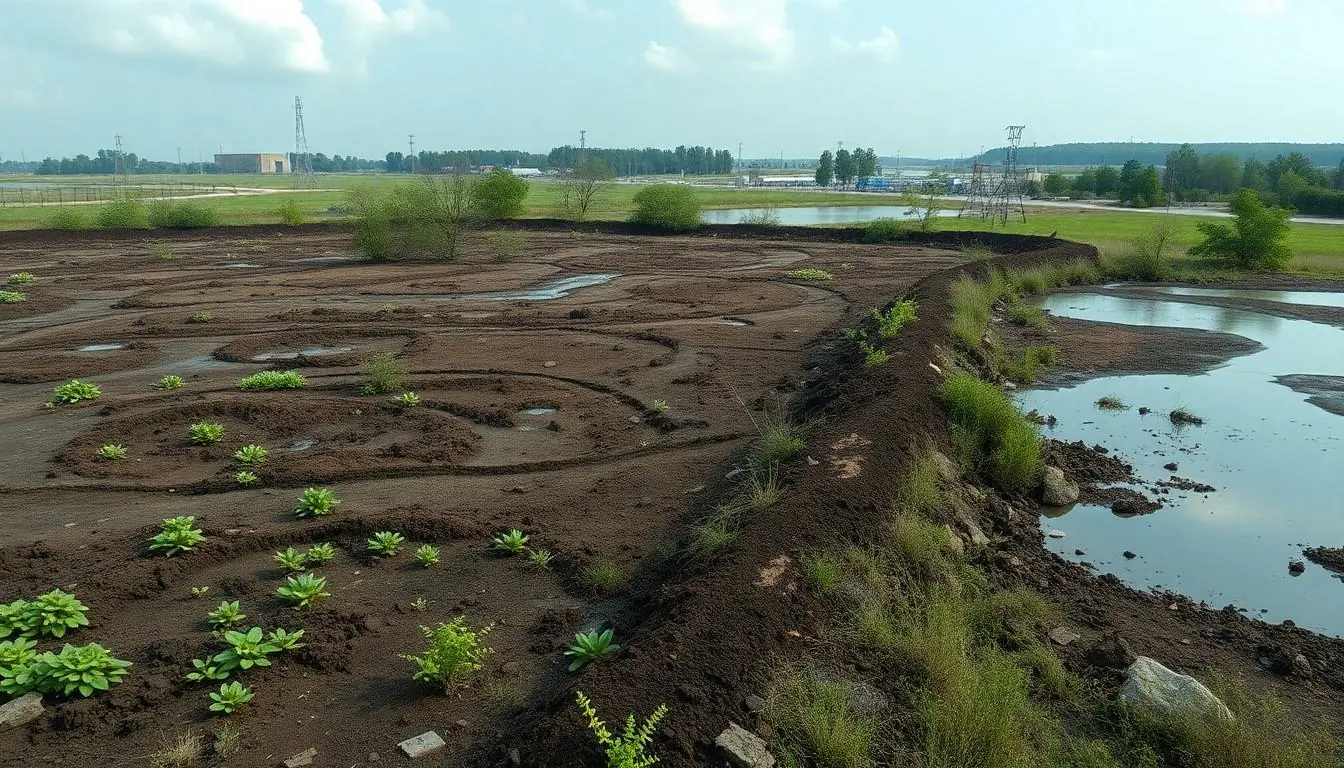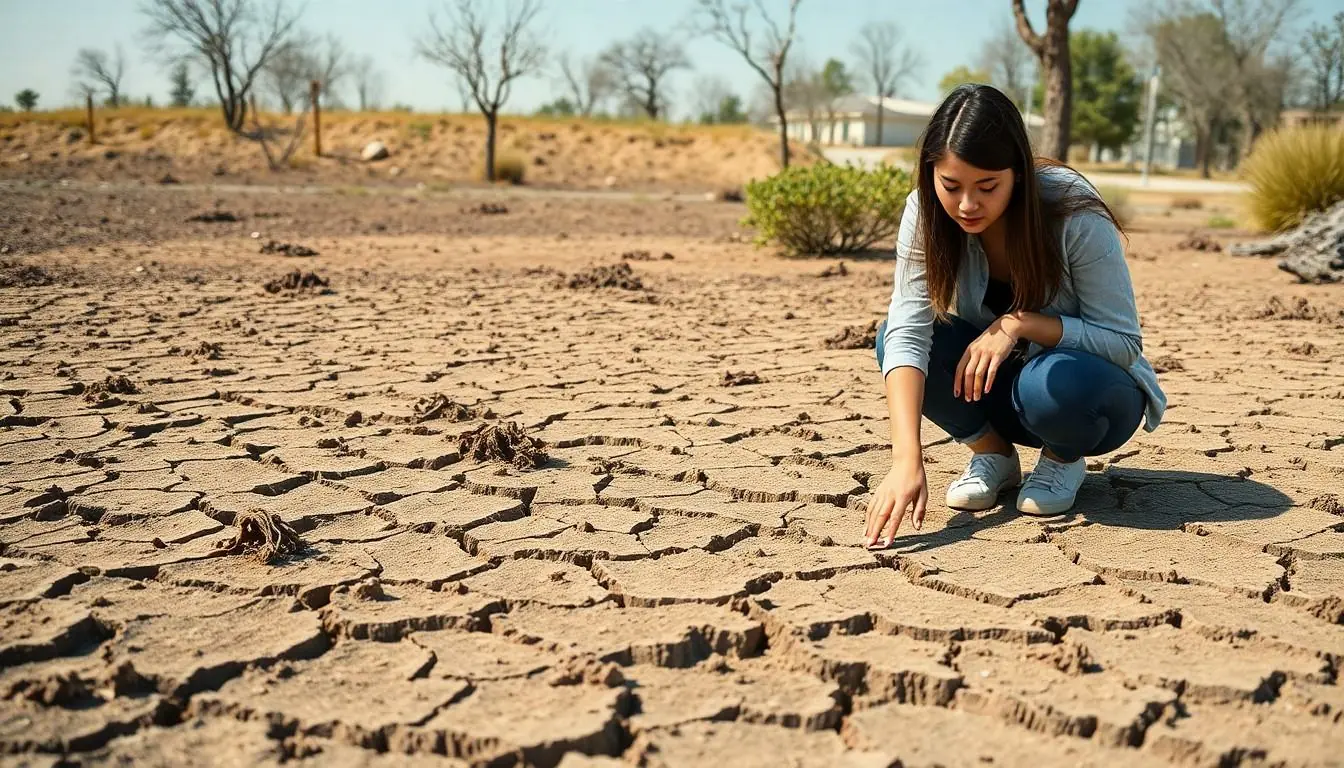Ground pollution might not be the most glamorous topic, but it’s a dirty little secret that affects us all. Picture this: your favorite park, once a lush green oasis, now resembles a post-apocalyptic wasteland. It’s not just a bad sci-fi movie plot; it’s the reality of contaminated soil that’s silently wreaking havoc on our environment and health.
Table of Contents
ToggleUnderstanding Ground Pollution
Ground pollution refers to the contamination of soil and land, which impacts ecosystems and human health. Various substances pollute the ground, leading to long-term environmental degradation.
Definition and Types
Ground pollution encompasses the introduction of harmful substances into the soil. Various types of ground pollution include chemical, biological, and radioactive contamination. Chemical pollution often results from agricultural pesticides, industrial wastes, and heavy metals. Biological pollution involves pathogens and microorganisms that disrupt natural soil processes. Lastly, radioactive pollution arises from nuclear waste and improper handling of radioactive materials. Each type contributes uniquely to the degradation of the earth’s resources.
Causes of Ground Pollution
Numerous factors cause ground pollution. Industrial activities frequently release toxic byproducts into the environment. Agricultural practices often involve excessive use of fertilizers and pesticides, which seep into the soil. Urban development leads to waste dumping in uncontrolled areas, impacting the surrounding land. Landfills contribute to soil contamination through leachate that mixes with natural groundwater. Natural disasters occasionally exacerbate the situation, spreading pollutants further and complicating remediation efforts.
Impact of Ground Pollution

Ground pollution poses significant threats to the environment and public health. Understanding these impacts is crucial for effective mitigation strategies.
Environmental Effects
Polluted soil disrupts ecosystems, affecting plant growth and aquatic habitats. Contaminated land diminishes biodiversity, leading to a loss of flora and fauna. Chemical pollutants can leach into groundwater, altering water quality and threatening both aquatic life and human consumption. Contaminated sites, if left untreated, may expand, resulting in widespread environmental degradation. Restoration efforts often face challenges due to persistent toxins, making recovery difficult. Ground pollution can transform thriving ecosystems into barren landscapes, reducing recreational spaces and diminishing the aesthetic value of natural areas.
Human Health Risks
Soil contamination poses direct and indirect risks to human health. Exposure to toxic substances can lead to serious health issues, including respiratory problems, skin diseases, and reproductive disorders. Ingesting contaminated food or water can result in long-term health complications, particularly for vulnerable populations such as children and pregnant women. Polluted agricultural lands can produce unsafe crops, heightening the risk of foodborne illnesses. Residents near contaminated sites often face increased anxiety and stress, impacting overall well-being. The community’s quality of life declines as ground pollution continues to pose serious health threats.
Monitoring Ground Pollution
Effective monitoring of ground pollution plays a vital role in identifying contamination sources and assessing environmental health. Reliable data collection techniques enable timely interventions, safeguarding ecosystems and communities.
Methods of Detection
Various methods are used to detect ground pollution. Soil sampling involves collecting soil from different depths, providing insights into contamination levels. Laboratory analysis of samples identifies specific pollutants, such as heavy metals or organic compounds. Remote sensing technology offers a non-invasive way to assess land degradation through satellite imagery. Geophysical surveys, including electrical resistivity and ground-penetrating radar, reveal subsurface contamination patterns. Each method contributes unique advantages, allowing for comprehensive assessments of pollution levels in affected areas.
Key Indicators
Key indicators of ground pollution help gauge soil health and ecosystem vitality. Elevated concentrations of certain heavy metals, including lead, arsenic, and mercury, indicate significant pollution. Changes in soil pH can signal issues like acidification caused by industrial waste. Presence of specific microorganisms, such as pathogens or toxic algae, alerts to biological contamination risks. Unusual vegetation growth patterns, including stunted or dying plants, reveal soil toxicity. Monitoring these indicators allows for early detection and remediation strategies, fostering healthier environments.
Strategies for Prevention and Remediation
Preventing and remediating ground pollution requires a multi-faceted approach. Effective strategies focus on sustainable practices and robust government regulations.
Sustainable Practices
Sustainable practices play a crucial role in preventing ground pollution. Implementing organic farming methods reduces chemical runoff into the soil. Using integrated pest management limits pesticide use, thus protecting soil health. Composting organic waste decreases landfill use while enriching soil quality. Establishing buffer zones around sensitive areas helps shield ecosystems from pollutants. Encouraging community gardens fosters local food production and raises awareness about soil health. Increasing education on pollution impacts empowers individuals to make informed choices. Promoting recycling and proper waste disposal minimizes harmful leachate from landfills.
Government Regulations
Government regulations are vital in managing ground pollution. Establishing strict guidelines for industrial waste disposal ensures companies reduce harmful emissions. Monitoring agricultural practices, such as fertilizer application rates, prevents excessive runoff into surrounding soil. Enforcing penalties for illegal dumping deters stakeholders from irresponsible behavior. Implementing land use planning reduces urban sprawl, limiting soil contamination. Mandating regular environmental assessments enables ongoing monitoring of contamination levels. Granting incentives for pollution remediation projects encourages businesses to adopt cleaner technologies. Strengthening public participation in environmental decision-making ensures community voices are heard.
Addressing ground pollution is essential for protecting both the environment and public health. The consequences of contaminated soil extend beyond immediate harm to ecosystems and communities. By implementing sustainable practices and enforcing robust regulations, it’s possible to mitigate these risks effectively.
Monitoring soil health through advanced detection methods ensures early intervention and fosters recovery. Collective efforts from individuals, communities, and governments are crucial in combating this often-overlooked issue. Prioritizing ground pollution prevention will lead to healthier ecosystems and safer living conditions for all.





